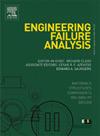Failure analysis of forged aluminium components
IF 4.4
2区 工程技术
Q1 ENGINEERING, MECHANICAL
引用次数: 0
Abstract
Defects identified as bubbles and fissures were found in aluminium components used in internal combustion engines forged from flat extruded bars. Samples exhibiting these features were sectioned and prepared for microstructural characterization using light optical and scanning electron microscopy. The analyses were also conducted in samples that did not have such defects for comparison. The bubbles revealed the presence of oxidation and carbon residues in their interior and a series of cracks that developed from them. The fractured surface of the cracked samples revealed the presence of similar residues. The study was complemented with metallographic observations on samples cut from extruded bars from which the components were forged to identify the origin of the defects in forged pieces. These studies revealed the presence of cracks and voids close to the surface of the extruded bars. Therefore, it was concluded that the bubbles and cracks originated from the lubricant used in forging trapped within the voids and cracks of the extruded bars. The lubricant will volatilize and expand in such a case, causing bubbles and cracks in the forged components. The analyses conducted to the establishment of a quality criterion for acceptance of extruded bars.
锻造铝部件的失效分析
在用扁平挤压棒锻造的内燃机铝部件中发现了气泡和裂缝等缺陷。使用光学显微镜和扫描电子显微镜对具有这些特征的样品进行切片和微结构表征。同时还对没有这些缺陷的样品进行了分析,以进行比较。气泡显示其内部存在氧化和碳残留物,并由此产生了一系列裂纹。裂纹样品的断裂表面也发现了类似的残留物。除了这项研究之外,还对从挤压棒材上切割下来的样品进行了金相观察,以确定锻造部件中缺陷的来源。这些研究表明,挤压棒表面附近存在裂缝和空隙。因此,得出的结论是,气泡和裂纹源于锻造过程中使用的润滑剂滞留在挤压棒的空隙和裂纹中。在这种情况下,润滑剂会挥发膨胀,导致锻造部件出现气泡和裂纹。通过分析,制定了验收挤压棒材的质量标准。
本文章由计算机程序翻译,如有差异,请以英文原文为准。
求助全文
约1分钟内获得全文
求助全文
来源期刊

Engineering Failure Analysis
工程技术-材料科学:表征与测试
CiteScore
7.70
自引率
20.00%
发文量
956
审稿时长
47 days
期刊介绍:
Engineering Failure Analysis publishes research papers describing the analysis of engineering failures and related studies.
Papers relating to the structure, properties and behaviour of engineering materials are encouraged, particularly those which also involve the detailed application of materials parameters to problems in engineering structures, components and design. In addition to the area of materials engineering, the interacting fields of mechanical, manufacturing, aeronautical, civil, chemical, corrosion and design engineering are considered relevant. Activity should be directed at analysing engineering failures and carrying out research to help reduce the incidences of failures and to extend the operating horizons of engineering materials.
Emphasis is placed on the mechanical properties of materials and their behaviour when influenced by structure, process and environment. Metallic, polymeric, ceramic and natural materials are all included and the application of these materials to real engineering situations should be emphasised. The use of a case-study based approach is also encouraged.
Engineering Failure Analysis provides essential reference material and critical feedback into the design process thereby contributing to the prevention of engineering failures in the future. All submissions will be subject to peer review from leading experts in the field.
 求助内容:
求助内容: 应助结果提醒方式:
应助结果提醒方式:


